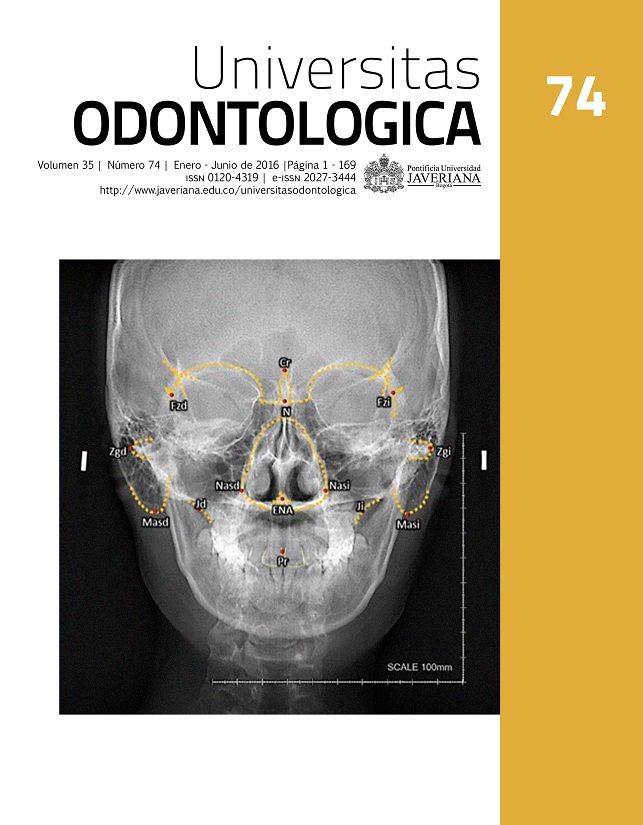Effect of occlusal forces over periodontium analyzed through finite elements
##plugins.themes.bootstrap3.article.details##
ABSTRACT. Background: Biomechanical effects of occlusal loads on teeth during clenching and in mastication have been evaluated. A harmful consequence of occlusal overload is tooth fracture, which has been analyzed through methods such as electrical tests, photo elasticity, and finite elements. Although there are numerous studies linking periodontal disease and occlusion, the biomechanical role of the forces exerted on the periodontium has not been studied enough. Objective: To evaluate the effect of normal and harmful occlusal forces on the periodontium through finite elements. Methods: The finite element analysis included the following steps: specification of geometry, element type, and material properties and force magnitudes in Newton’s (from 150 N to 675 N using 25 N increments) on the longitudinal axis of the tooth. Results: There was a statistically significant difference between the stress distribution in periodontal ligament, cortical bone, and dentine according to tooth type (p = 0.000), but not significant differences were observed in cancellous bone (p = 0.166). Conclusion: The concentration of stress was located in the three teeth, incisor, premolar, and molar, in the buccal cervical area where most stress distribution was evident in all magnitudes of force applied.
2. Benazzi S, Kullmer O, Grosse IR, Weber GW. Using occlusal wear information and finite element analysis to investigate stress distributions in human molars. J Anat. 2011 Sep; 219(3): 259-72.
3. Albuquerque RC, Polleto LT, Fontana RH, Cimini CA. Stress analysis of an upper central incisor restored with different posts. J Oral Rehabil. 2003; 30: 936-43.
4. Karring T, Nyman S, Thilander B, Magnusson I. Bone regeneration in orthodontically produced alveolar bone dehiscences. J Periodontal Res. 1982; 17: 309-15.
5. Ericsson I, Lindhe J. Effect of longstanding jiggling on experimental marginal periodontitis in the beagle dog. J Clin Periodontol. 1982; 9: 497-503.
6. Ren LM, Wang WX, Takao Y, Chen ZX. Effects of cementum-dentin junction and cementum on the mechanical response of tooth supporting structure. J Dent. 2010; 38(11): 882-91.
7. Litonjua LA, Andreana S, Patra AK, Cohen RE. An assessment of stress analyses in the theory of abfraction. Biomed Mater Eng. 2004; 14(3): 311-21.
8. Poiate IA, de Vasconcellos AB, de Santana RB, Poiate E. Three-dimensional stress distribution in the human periodontal ligament in masticatory, parafunctional, and trauma loads: finite element analysis. J Periodontol. 2009; 80(11): 1859-67.
9. Rottner K, Richter EJ. Effect of occlusal morphology on the accuracy of bite force measurements using thin film transducers. Int J Prosthodont. 2004 Sep-Oct; 17(5): 518-23.
10. Rees JS, Hammadeh M, Jagger DC. Abfraction lesion formation in maxillary incisors, canines and premolars: a finite element study. Eur J Oral Sci. 2003; 111(2): 149-54.
11. Dejak B, Mlotkowski A, Romanowicz M. Finite element analysis of mechanism of cervical lesion formation in simulated molars during mastication and parafunction. J Prosthet Dent. 2005; 94(6): 520-9.
12. Rees JS, Hammadeh M. Undermining of enamel as a mechanism of abfraction lesion formation: A finite element study. Eur J Oral Sci 2004; 112: 347-52.
13. Borák L, Florian Z, Bartáková S, Prachár P, Murakami N, Ona M, Igarashi Y, Wakabayashi N. Bilinear elastic property of the periodontal ligament for simulation using a finite element mandible model. Dent Mater J. 2011; 30(4): 448-54.
14. Spranger H. Investigation into the genesis of angular lesions at the cervical region of teeth. Quintessence Int. 1995 Feb; 26(2): 149-54.
15. Bartlett DW, Shah P. A critical review of non-carious cervical (wear) lesions and the role of abfraction, erosion, and abrasion. J Dent Res. 2006 Apr; 85(4): 306-12.
16. Consolaro A. Diagnosis of occlusal trauma: Extrapolations for peri-implant bone region can be done. Dental Press Implantol. 2012 Oct-Dec; 6(4): 22-37.
17. Rottner K, Richter EJ. Effect of occlusal morphology on the accuracy of bite force measurements using thin film transducers. Int J Prosthodont. 2004 Sep-Oct; 17(5): 518-23.
18. Bates JF, Stafford GD, Harrison A. Masticatory function. A review of the literature. J Oral Rehabil. 1975; 2: 281-301.
19. Craig RG. Mechanical properties. In: Craig RG, editor. Restorative dental materials, 6th edition. St. Louis, MO: Mosby; 1980. pp. 76-8.


